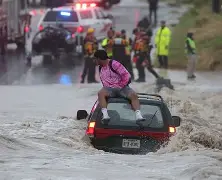Table of Contents
Severe flooding in Central Texas has left multiple people dead and dozens missing, prompting a large-scale mobilization of emergency rescue teams. Torrential rains overwhelmed rivers and dams across several counties, triggering flash floods and prompting urgent evacuations. As search-and-rescue operations intensify, the disaster underscores the rising toll of extreme weather events globally.
Torrential Rains Overwhelm Central Texas Infrastructure
Central Texas witnessed over 12 inches of rainfall in less than 48 hours, leading to flash flooding in areas such as Austin, San Marcos, and Wimberley. Rivers overflowed, roadways became impassable, and entire neighborhoods were submerged.
Governor Greg Abbott declared a state of emergency across 12 counties, while the National Weather Service issued continued flood warnings.
“This is one of the worst flooding events we’ve seen in years,” said Travis County Sheriff Andy Garcia. “Lives have been lost, and we are still accounting for the missing.”
More than 200 homes have been damaged or destroyed, and tens of thousands remain without power.
Rescue Teams Deployed as Water Levels Rise
In response, over 300 rescue personnel, including the Texas National Guard, FEMA, and local fire departments, have been deployed for swift water rescues and recovery efforts.
Boats, helicopters, and high-water vehicles are combing affected regions to reach stranded residents. Emergency shelters have been set up in churches, schools, and civic centers across Travis, Hays, and Bastrop counties.
Officials are urging citizens to avoid all flooded areas. “Turn around, don’t drown,” repeated local authorities, warning that even 6 inches of moving water can sweep away vehicles.
Climate Change and the Rising Frequency of Flash Floods
Meteorologists say this type of intense, localized rainfall is becoming more common due to climate change.
“Warmer air holds more moisture,” said Dr. Lila Thompson, a climate scientist at Texas A&M. “That means heavier rain over shorter periods, perfect conditions for flash floods.”
The flooding echoes past disasters in Texas, including the 2015 Memorial Day floods and Hurricane Harvey in 2017. Climate advocates are now pushing for improved drainage systems, flood-resistant infrastructure, and greater investment in emergency preparedness.
Implications / Why It Matters
The Central Texas floods are more than a local tragedy, they reflect a global pattern of extreme weather, raising urgent questions about infrastructure resilience, emergency response, and climate adaptation.
Long-tail search terms like “Texas flooding today,” “flash floods in Austin July 2025,” and “climate change impact on US weather” are trending internationally.
From Pakistan to Germany, extreme floods are displacing millions and damaging economies. For international readers, this event highlights the need for cross-border collaboration on climate action, disaster relief, and early warning systems.


